Memristive Devices from CuO Nanoparticles
Abstract
:1. Introduction
2. Materials and Methods
3. Characterization
4. Results and Discussion
5. Conclusions
Author Contributions
Funding
Conflicts of Interest
References
- Yang, J.J.; Pickett, M.D.; Li, X.; Ohlberg, D.A.A.; Stewart, D.R.; Williams, R.S. Memristive switching mechanism for metal/oxide/metal nanodevices. Nat. Nanotechnol. 2008, 3, 429–433. [Google Scholar] [CrossRef]
- Zhu, Y.B.; Zheng, K.; Wu, X.; Ang, L.K. Enhanced stability of filament-type resistive switching by interface engineering. Sci. Rep. 2017, 7, 43664. [Google Scholar] [CrossRef] [Green Version]
- Wang, W.; Jing, T.T.; Butcher, B. cFPGA: CNT emerging memory-based FPGA. In Proceedings of the 2010 IEEE International Symposium on Circuits and Systems, Paris, France, 30 May–2 June 2010; pp. 1444–1447. [Google Scholar] [CrossRef]
- Britnell, L.; Gorbachev, R.V.; Geim, A.K.; Ponomarenko, L.A.; Mishchenko, A.; Greenaway, M.T.; Fromhold, T.; Novoselov, K.S.; Eaves, L. Resonant tunnelling and negative differential conductance in graphene transistors. Nat. Commun. 2013, 4, 1794. [Google Scholar] [CrossRef] [PubMed] [Green Version]
- Suzuki, S.; Asada, M.; Teranishi, A.; Sugiyama, H.; Yokoyama, H. Fundamental oscillation of resonant tunneling diodes above 1 THz at room temperature. Appl. Phys. Lett. 2010, 97, 242102. [Google Scholar] [CrossRef]
- Xia, Q.; Robinett, W.; Cumbie, M.W.; Banerjee, N.; Cardinali, T.J.; Yang, J.J.; Wu, W.; Li, X.; Tong, W.M.; Strukov, D.B.; et al. Memristor−CMOS Hybrid Integrated Circuits for Reconfigurable Logic. Nano Lett. 2009, 9, 3640–3645. [Google Scholar] [CrossRef] [PubMed]
- Kumar, A.; Rawal, Y.; Baghini, M.S. Fabrication and characterisation of the ZnO-based Memristor. In Proceedings of the 2012 International Conference on Emerging Electronics, Mumbai, India, 15–17 December 2012; pp. 1–3. [Google Scholar]
- Sawa, A.; Fujii, T.; Kawasaki, M.; Tokura, Y. Hysteretic current-voltage characteristics and resistance are switching at a rectifying Ti/Pr0.7Ca0.3MnO3Ti∕Pr0.7Ca0.3MnO3 interface. Appl. Phys. Lett. 2004, 85, 4073. [Google Scholar] [CrossRef] [Green Version]
- Ge, R.; Wu, X.; Kim, M.; Shi, J.; Sonde, S.; Tao, L.; Zhang, Y.; Lee, J.C.; Akinwande, D. Atomristor: Nonvolatile Resistance Switching in Atomic Sheets of Transition Metal Dichalcogenides. Nano Lett. 2017, 18, 434–441. [Google Scholar] [CrossRef]
- Fu, X.; Zhang, L.; Cho, H.D.; Kang, T.W.; Fu, D.; Lee, D.; Lee, S.W.; Qi, T.; Chan, A.S.; Yunusov, Z.A.; et al. Molybdenum disulfide nanosheet/Quantum dot dynamicmemristive structure driven by photoinduced phase transition. Small 2019, 15, 1903809. [Google Scholar] [CrossRef]
- Kim, M.-K.; Lee, J.-S. Design of Electrodeposited Bilayer Structures for Reliable Resistive Switching with Self-Compliance. ACS Appl. Mater. Interfaces 2016, 8, 32918–32924. [Google Scholar] [CrossRef]
- Han, J.-W.; Meyyappan, M. Copper oxide resistive switching memory for e-textile. AIP Adv. 2011, 1, 032162. [Google Scholar] [CrossRef]
- Wang, S.Y.; Huang, C.W.; Lee, D.Y.; Tseng, T.Y.; Chang, T.C. Multi-level resistive switching in Ti/CuxO/PtTi/CuxO/Pt memory devices. J. Appl. Phys. 2010, 108, 114110. [Google Scholar] [CrossRef]
- Park, K.; Lee, J.S. Flexible resistive switching memory with a Ni/CuO x /Ni structure using an electrochemical deposition process. Nanotechnology 2016, 27, 125203. [Google Scholar] [CrossRef] [PubMed]
- Wei, L.L.; Shang, D.; Sun, J.R.; Lee, S.B.; Sun, Z.G.; Shen, B.G. Gradual electroforming and memristive switching in Pt/CuOx/Si/Pt systems. Nanotechnology 2013, 24, 325202. [Google Scholar] [CrossRef]
- Lin, C.-C.; Wu, P.-H.; Chang, Y.-P. Effects of crystallization and non-lattice oxygen atoms on Cu(x)O-based resistive switching memory. J. Nanosci. Nanotechnol. 2013, 13, 483–486. [Google Scholar] [CrossRef]
- Yang, Y.; Qi, J.; Guo, W.; Qin, Z.; Zhang, Y. Electrical bistability and negative differential resistance in single Sb-doped ZnO nanobelts/SiOx/SiOx/p-Si heterostructured devices. Appl. Phys. Lett. 2010, 96, 093107. [Google Scholar] [CrossRef]
- Rathi, S.; Lee, I.; Kang, M.; Lim, D.; Lee, Y.; Yamauchi, S.; Joh, H.I.; Kim, S.; Kim, S.W.; Yun, S.J.; et al. Observation of Negative Differential Resistance in Mesoscopic Graph Oxide Devices. Sci. Rep. 2018, 1, 7144. [Google Scholar] [CrossRef]
- Chen, J. Large On-Off Ratios and Negative Differential Resistance in a Molecular Electronic Device. Science 1999, 286, 1550–1552. [Google Scholar] [CrossRef] [PubMed] [Green Version]
- Wu, Y.; Farmer, D.B.; Zhu, W.; Han, S.-J.; Dimitrakopoulos, C.D.; Bol, A.A.; Avouris, P.; Lin, Y.-M. Three-Terminal Graphene Negative Differential Resistance Devices. ACS Nano 2012, 6, 2610–2616. [Google Scholar] [CrossRef]
- Kumar, A.; Das, M.; Garg, V.; Sengar, B.S.; Htay, M.T.; Kumar, S.; Kranti, A.; Mukherjee, S. Forming-free high-endurance Al/ZnO/Al memristor fabricated by dual ion beam sputtering. Appl. Phys. Lett. 2017, 110, 253509. [Google Scholar] [CrossRef]
- Zhou, G.; Duan, S.; Li, P.; Sun, B.; Wu, B.; Yao, Y.; Yang, X.; Han, J.; Wu, J.; Wang, G.; et al. Coexistence of NDR and resistive switching memory at room temperature in Ti)x modulated by moisture. Adv. Electron. Mater. 2018, 4, 1700567. [Google Scholar] [CrossRef]
- Zhou, L.; Yang, S.-W.; Ng, M.-F.; Sullivan, M.B.; Tan, V.B.C.; Shen, L. One-Dimensional Iron−Cyclopentadienyl Sandwich Molecular Wire with Half Metallic, Negative Differential Resistance and High-Spin Filter Efficiency Properties. J. Am. Chem. Soc. 2008, 130, 4023–4027. [Google Scholar] [CrossRef] [PubMed]
- Kadhim, M.S.; Yang, F.; Sun, B.; Wang, Y.; Guo, T.; Jia, Y.; Yuan, L.; Yu, Y.; Zhao, Y. A resistive switching memory device with a negative differential resistance at room temperature. Appl. Phys. Lett. 2018, 113, 053502. [Google Scholar] [CrossRef]
- Diachenko, O.V.; Opanasuyk, A.S.; Salohub, A.O.; Nam, D.; Cheong, H.; Gnatenko, Y.P. Structural Features of Nanostructured Copper Oxide Thin Films, Synthesized by Spray Pyrolysis Technique. In Proceedings of the International Conference on Nanomaterials: Applications and Properties; Sumy State University: Sumy, Ukraine, 2015; Volume 4. [Google Scholar]
- Morita, M.; Ohmi, T.; Hasegawa, E.; Kawakami, M.; Ohwada, M. Growth of native oxide on a silicon surface. J. Appl. Phys. 1990, 68, 1272–1281. [Google Scholar] [CrossRef]
- Baranovski, S.; Rubel, O. Description of Charge Transport in Amorphous Semiconductors. Charg. Transp. Disord. Solids Appl. Electron. 2006, 49–96. [Google Scholar]
- Takeshita, S. Modelling of Space Charge Limited Current Injection Incorporating an Advanced Model of the Poole-Frenkel Effect. Master’s Thesis, Clemson University, Clemson, SC, USA, 2008. [Google Scholar]
- Geurst, J.A. Theory of Space-Charge-Limited Currents in Thin Semiconductor Layers. Phys. Status Solidi 1966, 15, 107–118. [Google Scholar] [CrossRef]
- Ran, X.; Hou, P.; Song, J.; Song, H.; Zhong, X.; Wang, J. Negative differential resistance effect in resistive switching devices based on h-LuFeO3/CoFe2O4 heterojunctions. Phys. Chem. Chem. Phys. 2020, 22, 5819–5825. [Google Scholar] [CrossRef]
- Wu, X.; Cha, N.; Bosman, M.; Raghavan, N.; Migas, D.B.; Borisenko, V.E.; Zhang, X.; Li, K.; Pey, K.L. Intrinsic nanofilamentation in resistive switching. J. Appl. Phys. 2013, 113, 114503. [Google Scholar] [CrossRef] [Green Version]
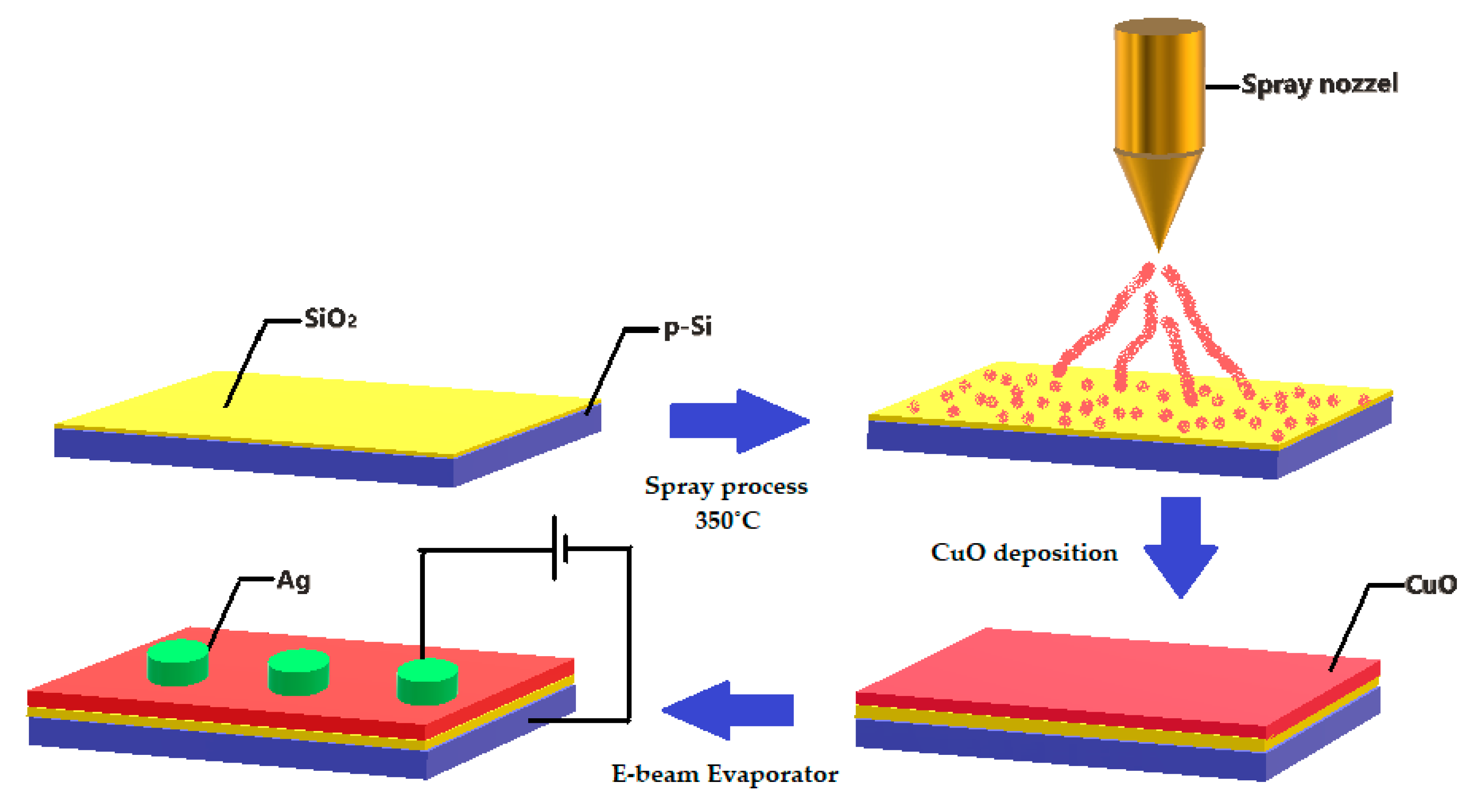
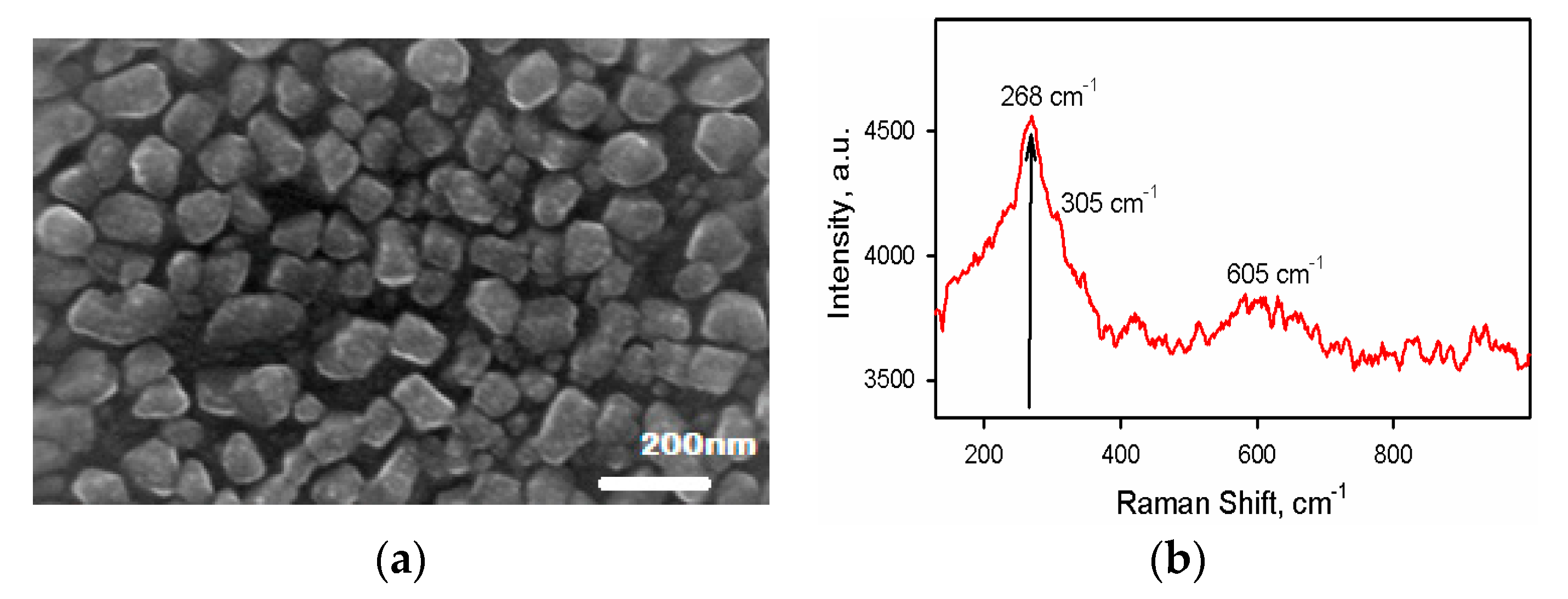
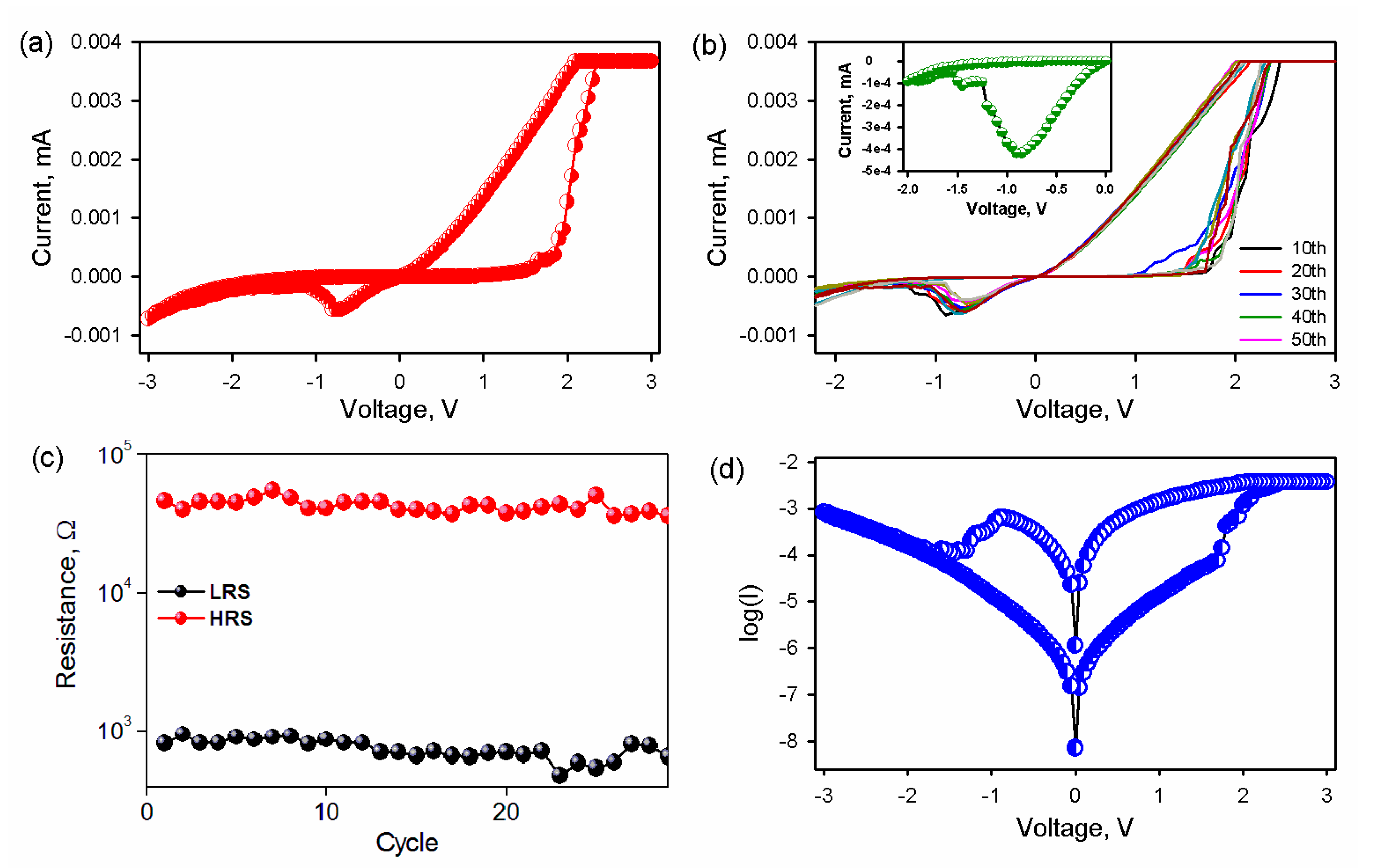
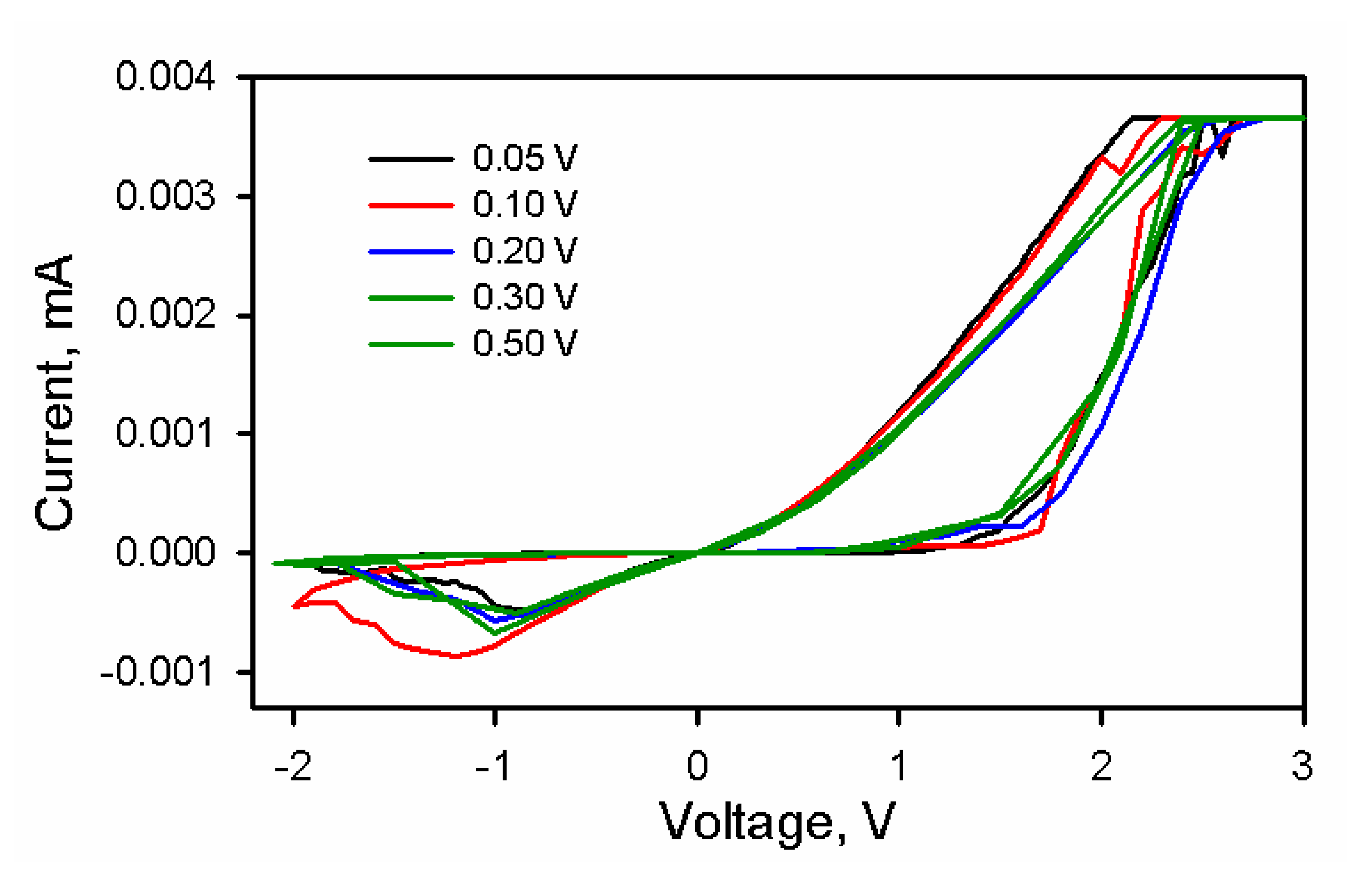

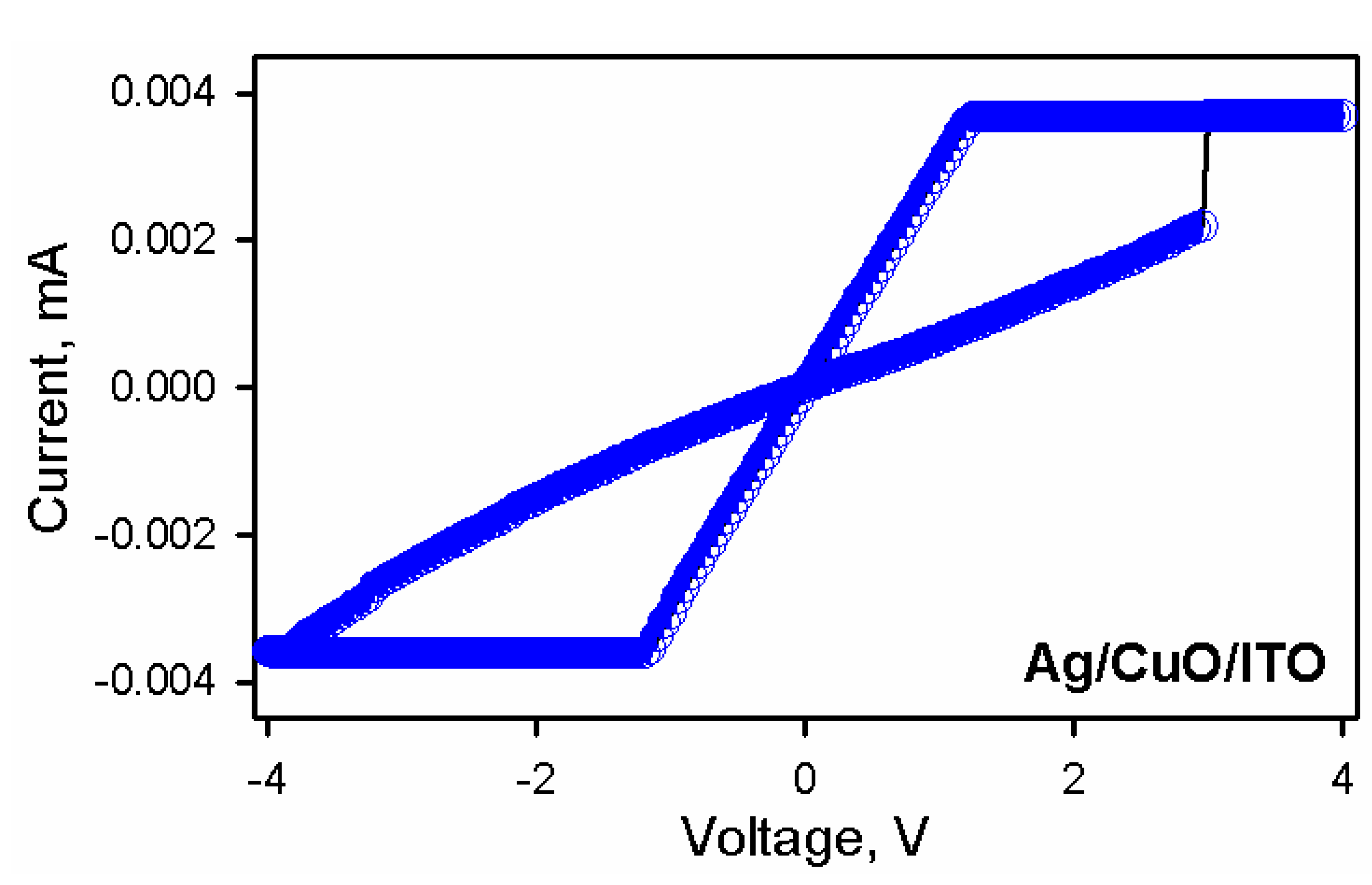
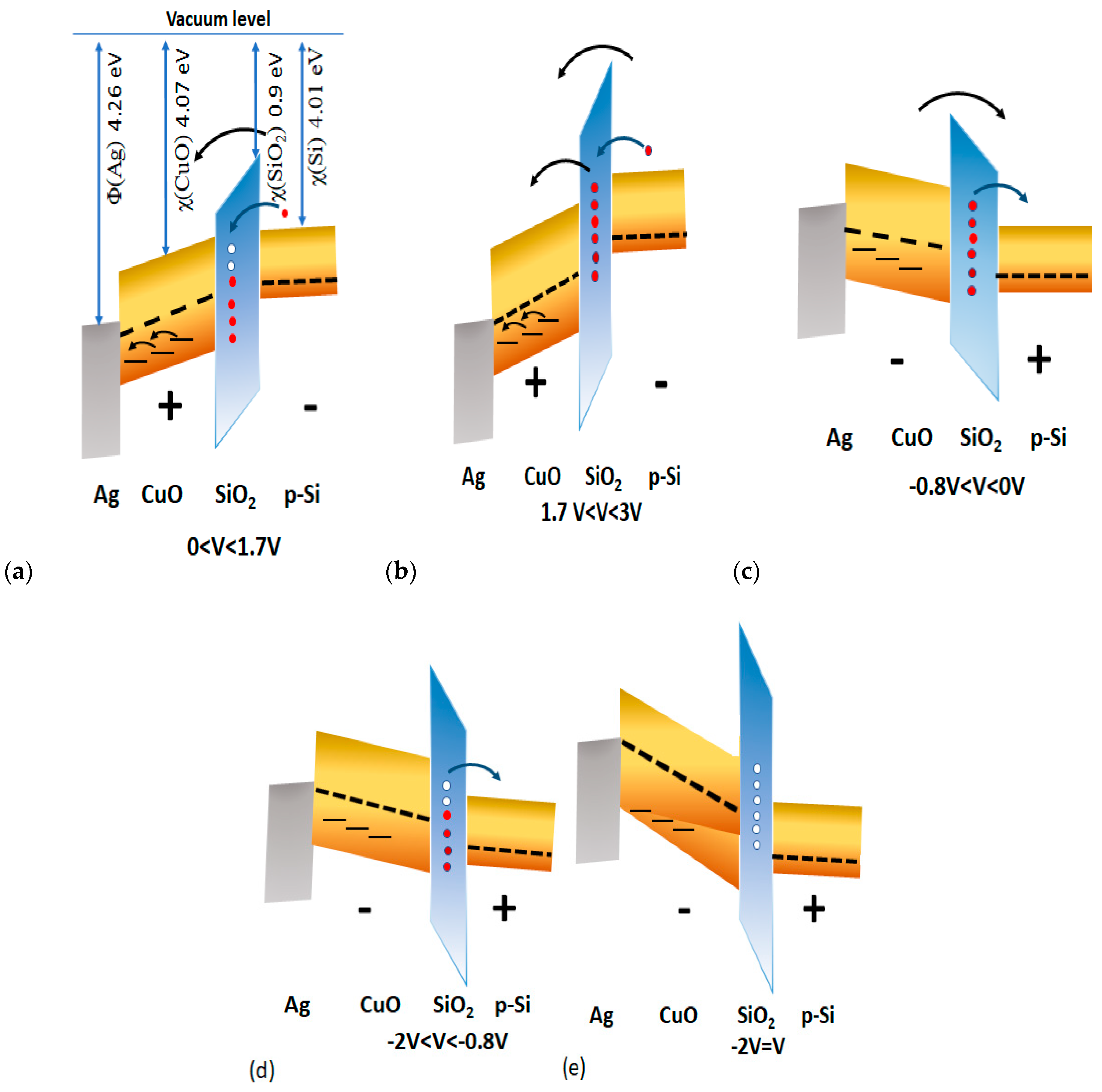
© 2020 by the authors. Licensee MDPI, Basel, Switzerland. This article is an open access article distributed under the terms and conditions of the Creative Commons Attribution (CC BY) license (http://creativecommons.org/licenses/by/4.0/).
Share and Cite
Walke, P.D.; Rana, A.u.H.S.; Yuldashev, S.U.; Magotra, V.K.; Lee, D.J.; Abdullaev, S.; Kang, T.W.; Jeon, H.C. Memristive Devices from CuO Nanoparticles. Nanomaterials 2020, 10, 1677. https://doi.org/10.3390/nano10091677
Walke PD, Rana AuHS, Yuldashev SU, Magotra VK, Lee DJ, Abdullaev S, Kang TW, Jeon HC. Memristive Devices from CuO Nanoparticles. Nanomaterials. 2020; 10(9):1677. https://doi.org/10.3390/nano10091677
Chicago/Turabian StyleWalke, Pundalik D., Abu ul Hassan Sarwar Rana, Shavkat U. Yuldashev, Verjesh Kumar Magotra, Dong Jin Lee, Shovkat Abdullaev, Tae Won Kang, and Hee Chang Jeon. 2020. "Memristive Devices from CuO Nanoparticles" Nanomaterials 10, no. 9: 1677. https://doi.org/10.3390/nano10091677




